5.1. Sound based testing
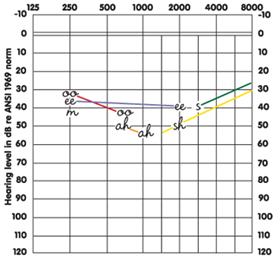
Ling 6 Sounds
Introduction
In 1976 Daniel Ling (16th March 1926–9th August 2003) devised a quick and easy, technology-free method for assessing the frequency range of human hearing (Ling, 1976). Ling determined that the following sounds would be appropriate to cover the frequency range of English speech and be able to discriminate between the different phonemes. The Ling Sounds have been modified and tweaked over the years, especially for CIs where the ‘oo’ phoneme is sometimes changed to the ‘u’ phoneme (O’Donoghue, Nikolopoulos, & Archbold, 2000). Additionally, /m/ (mm) was added to cover the lower frequency and was added to the ‘Ling 5’ to make it the ‘Ling 6’ in 1995 (Robb, Flexer, & Rose, 2005).
This sound check is very basic and simple to apply as each sound is its own phoneme, so no ‘language’ is needed to decode for meaning. This makes it suitable to use on a wide range of people, from the very young to older people. While there are few peer-reviewed studies on the effectiveness of Ling Sounds, their use is ubiquitous. The Ling Sounds have been modified over the years to suit local languages and dialects. There are also several variations in the delivery of the Ling 6 Sounds.
Table 1: The Ling sounds frequency range – note some bands have lower power intensity.
|
Phoneme (English) |
Phoneme – IPA Code | Frequency Range(s) (Hz) | |||
| Mm | /m/ | 250-350 | 1000-1500 | 2500-3500 | |
| Oo | /u/ | 200-500 | 650-1170 | ||
| Ah | /a/ | 225-775 | 825-1275 | ||
| Ee | /i/ | 150-450 | 2300-2900 | ||
| Sh | /ʃ/ | 1500-2000 | 4500-5500 | ||
| Ss | /s/ | 5000-6000 | |||
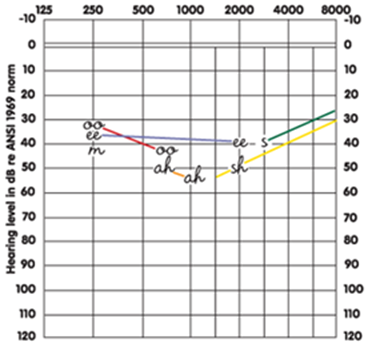
Figure 1. Key frequency parts of the Ling Sounds (Aberdeen School for the Deaf, 2022).
Procedure:
This video outlines how to deliver the Ling sounds:
(CID, 2016).
- All of the sounds must be presented at normal conversational level.
- Ensure the CYP is not able to see your lips.
- Ensure each utterance is the same duration.
- Present the phonemes in a random order (you can also include silence).
- The CYP should either verbalise what they heard or point to the answer on the picture card.
https://soundspeechnj.com/blog/2019/7/24/what-the-heck-are-the-ling-six-sounds (Harp, 2019).
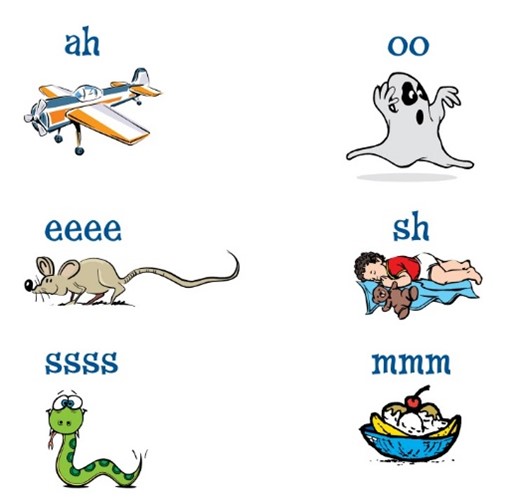
Figure 2. Ling sounds picture card
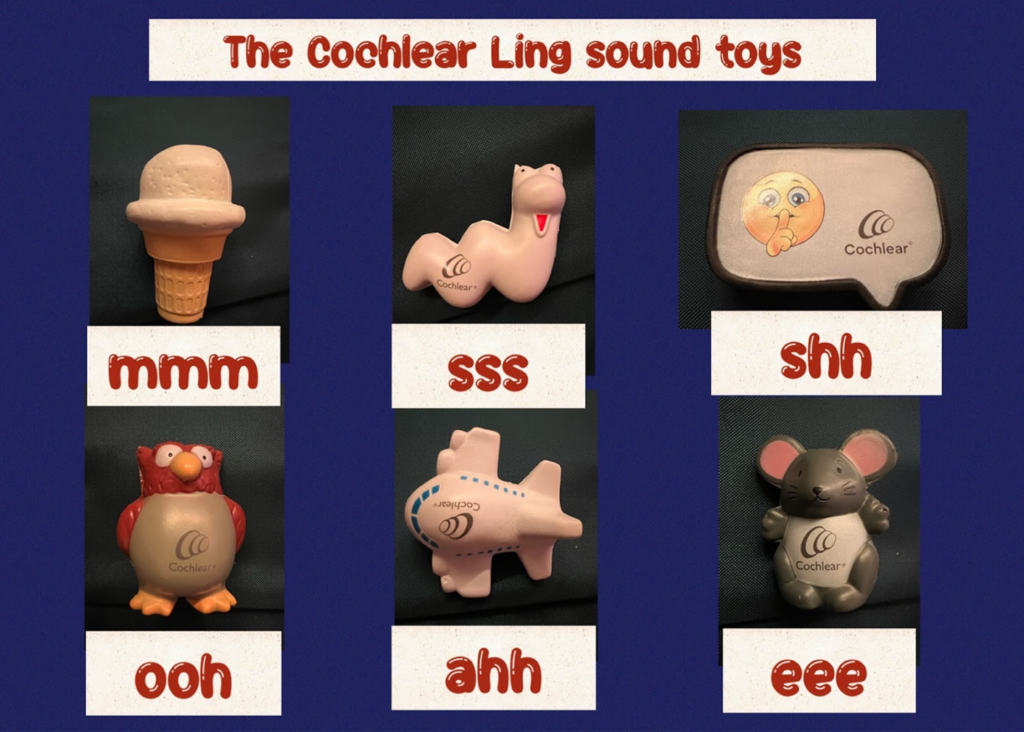
Figure 3. Ling sounds sound toys
Variations:
There are several variants to the procedure listed above:
- Distance from participant – some recommend: 1 metre (m), 2 m, or 4 m
- Using the picture cards
- Location of speaker – in front, behind, or to the side of the participant
- Voice of speaker – male, female, or computer
- Using an acoustically permeable fabric that occludes the participant from seeing the speaker’s mouth and jaw, or having the participant close their eyes
- Hearing devices programming settings
- Varying the phoneme intensity
- Repeating phonemes, eg (/m/ /m/ /m/) before response from participant.
Note: Most hearing devices will attenuate (reduce volume) sounds from the side or behind.
Considerations for QToDs:
This sound check is useful as it is quick, easy, and technology free. It has been around for a long time, but it is only used as an indicator of any issues and should be followed up by a more robust assessment or referral to a clinical audiologist.
Further reading:
Ling Sounds resources (Global South) – BATOD
The-Ling-Six-Sound-Check.pdf (advancedbionics.com)
The Ling 6 Sound Test – PDF Free Download (docplayer.net)
Ling-Madell-Hewitt (LMH) (low-mid-high frequency) sounds
Introduction
This sound check is a further development of the Ling Sounds; it may be worth reading the Ling section first.
In 1976, Daniel Ling (16th March 1926–9th August 2003) devised a quick and easy, technology-free method for assessing the frequency range of human hearing (Ling, 1976). In 2021 Jane Madell and Joan Hewitt further developed the six Ling Sounds phonemes with the addition of four phonemes. These four phonemes are /n/, /h/, /z/, and /dȝ/(AG Bell, 2022). An article about LMH was released in BATOD in March 2022 by Madell and Hewitt (Madell & Hewitt, The Ling-Madell-Hewitt (LMH) Test Battery, 2022), which was rebuked by Peter Keen in the subsequent issue in May 2022 (Keen, 2022).
Currently, some QToDs are unaware of the LMH Sounds; some use them, and some are waiting for further guidance. As this is a new addition, there are no peer-reviewed sources validating the effectiveness of the LMH over the Ling. However, LMH usage is spreading rapidly despite issues with the pronunciation of some of the phonemes.
Note: Sometimes, /dȝ/ can be written as /dj/ as not all font styles are capable of the ‘ȝ’ symbol.
Table 2: The Ling Sounds Frequency Range (McKarns, n.d.) (AG Bell, 2022) – note some bands have lower power intensity. Note the additional 4 phonemes are in bold.
| Phoneme (English) | Phoneme – IPA Code | Frequency Range(s) (Hz) | |||
| Mm | /m/ | 250-350 | 1000-1500 | 2500-3500 | |
| Oo | /u/ | 200-500 | 650-1170 | ||
| Ah | /a/ | 225-775 | 825-1275 | ||
| Ee | /i/ | 150–450 | 2300-2900 | ||
| Sh | /ʃ/ | 1500-2000 | 4500-5500 | ||
| Ss | /s/ | 5000-6000 | |||
| N(uh) | /n/ | 250-350 | 1000-1500 | 2000-3000 | |
| H(uh) | /h/ | 1500-2000 | |||
| Zz | /z/ | 200-400 | 4000-5000 | ||
| J(ur) | /dȝ/ | 200-300 | 2000-3000 | ||
Procedure:
There is no video at present on how to deliver this assessment.
- All of the sounds must be presented at normal conversational level.
- Ensure the CYP is not able to see your lips.
- Ensure each utterance is the same duration.
- Present the phonemes in a random order (you can also include silence).
- The CYP should either verbalise what they heard or point to the answer on the picture card (Madell & Hewitt, LMH Test, 2021).
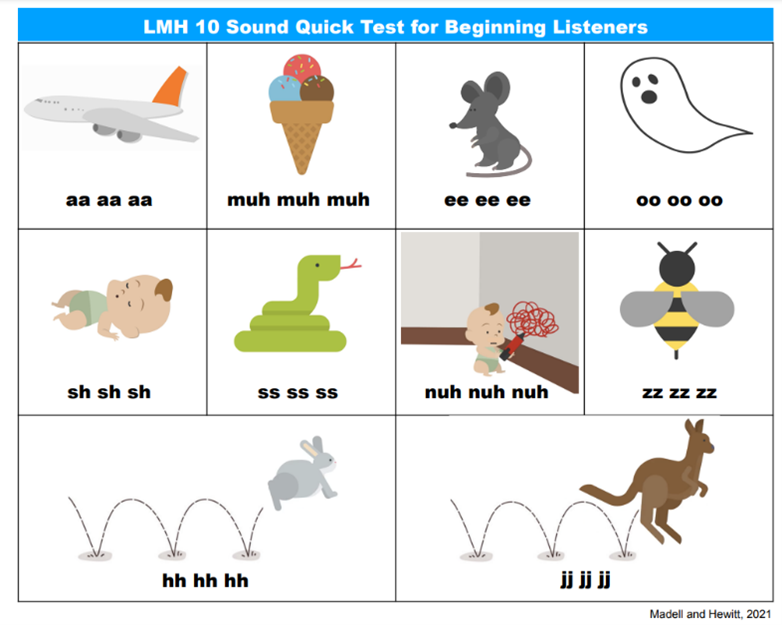
Figure 3: LMH sounds picture card
How to present the LMH test
- Repeat each sound three times
- Try and make the length of the presentation equal with all the sounds
- Present them in random order
See the monitoring recording sheet: http://www.janemadell.com/LMH_Discussion.pdf
Test with:
- Right ear technology alone
- Left ear technology alone
- Binaural technology
- Binaural technology plus remote microphone.
Variations:
There are several potential variants to the procedure listed above – these are similar to the Ling Sounds:
- Distance from participant – some recommend: 1 m, 2 m, or 4 m
- Using the picture cards
- Location of speaker – in front, behind, or to the side of participant
- Voice of speaker – male, female, or computer
- Using an acoustically permeable fabric that occludes the participant from seeing the speaker’s mouth and jaw, or having the participant close their eyes
- Hearing devices programming settings
- Varying the phoneme intensity
- Repeating phonemes, eg (/m/ /m/ /m/) before response from participant.
Note: Most hearing devices will attenuate (reduce the volume of) sounds from the side or behind.
Considerations for QToDs:
This sound check is useful as it is easy and technology free; however, it has more phonemes and sections in the checks, which may increase the time taken to administer it. It has not been around for a long time as its own entity. It is only used as an indicator of an issue and should be followed up by a more robust assessment or referral to a clinical audiologist.
Note: There are several issues to address
- It is impossible to utter the /dȝ/ phoneme on its own where it can be detectable – to get the duration it needs a vowel to ‘carry’ the sound.
- A recently published update includes changes to the /m/ phoneme, which are different from what QToDs have been using for the last 40 years – the author has said either can be used as appropriate (Madell & Hewitt, LMH Test, 2021).
- No official training has been offered by the author on the correct way to pronounce the phonemes – despite this, about 50% of QToDs are using this listening check.
Further reading:
Please see the references below for further information
References
Please see the references below for further information.
AG Bell. (2022, January 29). The Ling-Madell-Hewitt (LMH) Test Battery. Retrieved August 22, 2022, from AG Bell Volta Voices
Aberdeen School for the Deaf. (2022). Ling Sounds. Retrieved from AsfD
CID. (2016). CID Quick Tips: How to Conduct the Ling Sound Test. Retrieved from Youtube
Harp, T. (2019). What the Heck are the Ling Six Sounds?? Retrieved from Sound Speech
Keen, P. (2022, May). The Ling 6 Sounds Test. BATOD, pp. 40–55.
Ling, D. (1976). Hearing Aids and the Use of Residual Hearing. Australian Journal of Huma Communication Disorders, 4(1), 9-14. Retrieved August 4, 2022, from
Ling, D. (1976). Speech and the Hearing-impaired Child: Theory and Practice. Alex Graham Bell Association for Deaf.
Madell, J., & Hewitt, J. (2021). LMH Test. Retrieved from Janemadell
Madell, J., & Hewitt, J. (2022, March). The Ling-Madell-Hewitt (LMH) Test Battery. BATOD, pp. 20–23.
McKarns, S. (n.d.). Then Ling Thing: How to Administer the Ling Six Sounds Test. Audiology Practices. Retrieved August 4, 2022
O’Donoghue, G. M., Nikolopoulos, T. P., & Archbold, S. M. (2000). Determinants of speech perception in children after cochlear implantation. The Lancet, 356, 466-468. Retrieved August 2, 2022
Robb, Flexer, & Rose. (2005). The Ling six-sound test. Retrieved from The Auditory-Options Project
Next pages in this section
5.5 Sentence testing
5.6 Automated tests
5.7 Parent/guardian reports (under construction)
5.8 Teacher reports (under construction)
5.9 Children and young people reports (under construction)
Other sections
- Section 1 Anatomy and physiology of the ear
- Section 2 Aetiology and types of deafness
- Section 3 Auditory perception and hearing testing
- Section 4 Acoustics and physics of sound
- Section 6 Hearing technologies




